
The Promised Land
I am coming to think it may not be a bad thing for a society to have a shared notion of god, even if it is filtered through a religious apparatus. Whether it is one god or many; male, female, bi or gay; has horns, hands or cloven feet is immaterial, the important thing is the notion that there is something bigger than us, something that binds us. Something like the relationship between dogs and humans – fear and love in equal quantities. God in South Africa and Ukraine is lost, hiding, or shot; god in Namibia seems happy and well.
Don't think I am going all religious on you; I'm just as atheistic as ever – but god is very useful when faced with the inexplicable. How else to illustrate the contrast between South Africa and Namibia?
Luderitz
The Benguila Current flows north from the Antarctic up the West African coast bringing very cold water. In the middle of summer the sea off Namibia is 13C and so thick with life that it looks like soup. The watermaker filters clog in record time. There is seaweed, kelp, fish, jellyfish, lobster, prawns, whales, dolphins and birds – especially pelicans and flamingos. Why does this cold Antarctic water have more life than warm sun-drenched tropical water? It is no answer to say 'nutrients' because 'nutrients' are simply more life. It's life all the way down to the simplest plankton. So maybe that's the answer – plankton, but where does the plankton come from? From under the Antarctic ice? It doesn't seem likely. There is something missing from this textbook explanation.
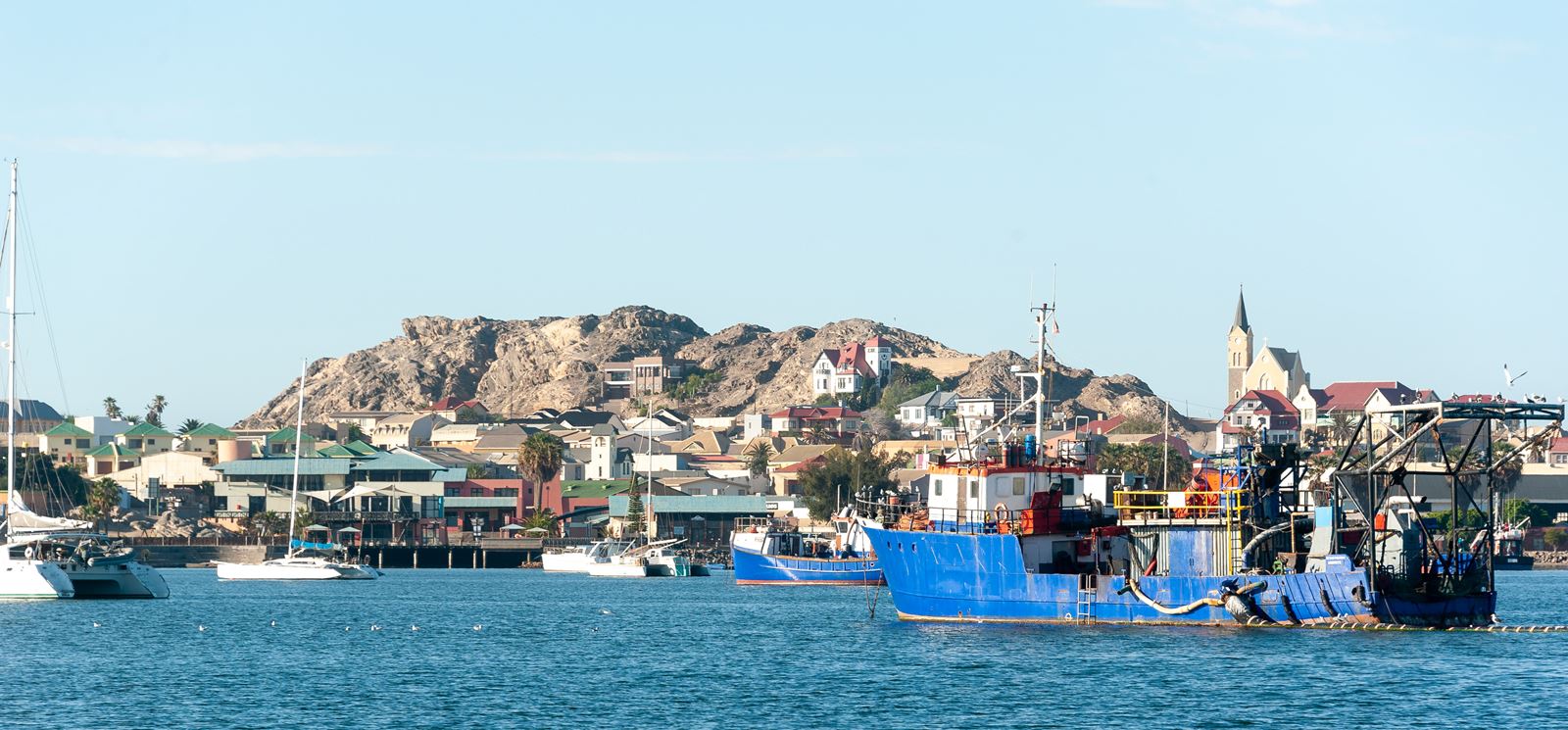
↑ Luderitz from our anchorage off the fish factory.
We anchor off the Luderitz fish factory just before dawn after a three and a half day sail from Cape Town. Later that morning a row boat appears.
"Welcome to Luderitz, I'm Andy." says the rower, a fit-looking chap with an English accent in his early sixties.
"The holding is not too good here. You'll likely drag in the next blow. I can let you have one of those moorings" he says, pointing in the direction of the yacht club. "It's closer in and much safer."
We negotiate a daily rate and select the mooring closest to the yacht club.
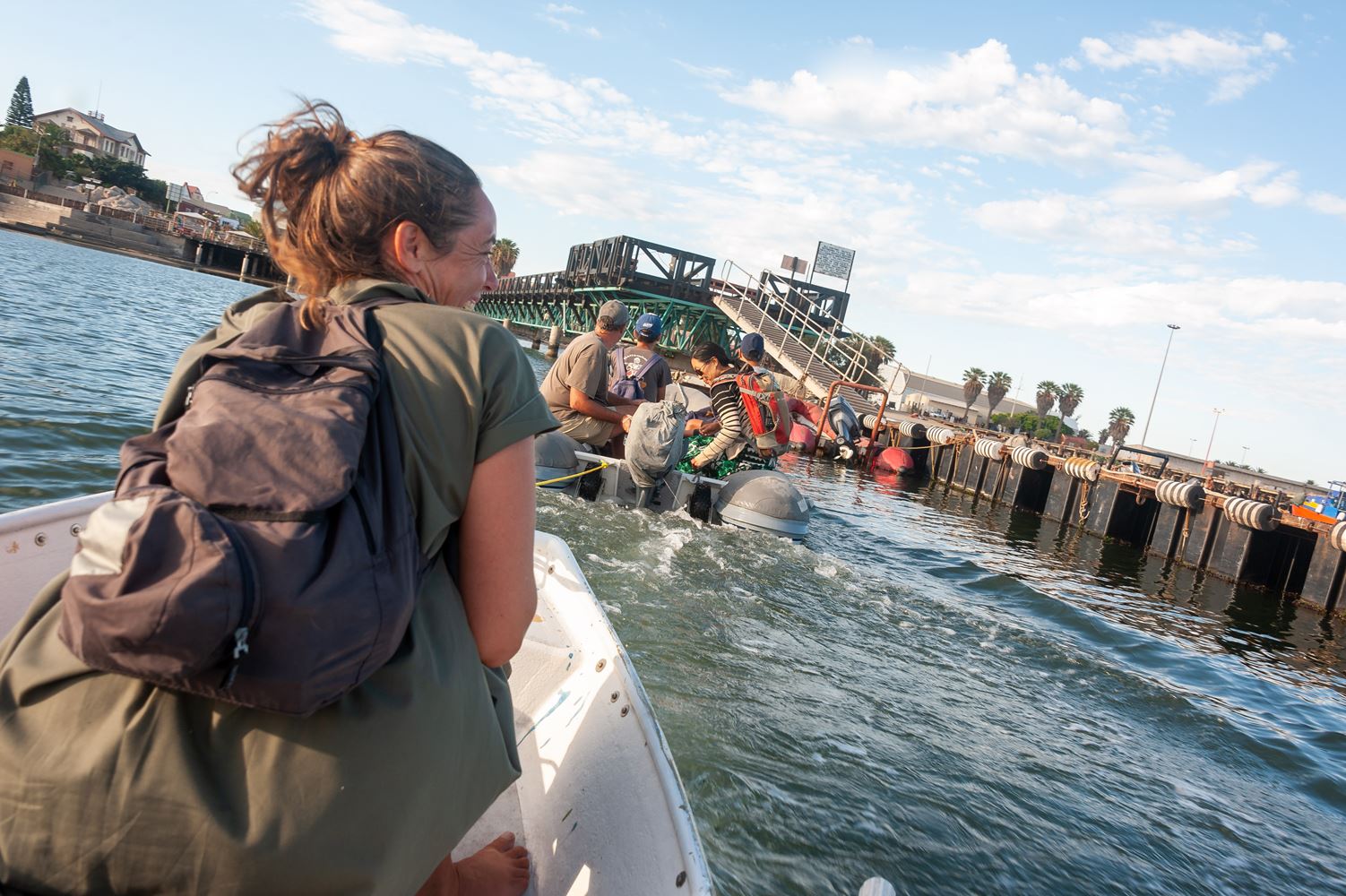
↑ Getting a lift into town.
With a negative covid test from Cape Town, clearing in to Namibia in Luderitz is easy. Health officials just want the test result, and Immigration and Customs are friendly and easy to please with the usual paperwork. We satisfy everyone and are cleared to stay for 90 days.
After a couple of beers at the Luderitz Yacht Club followed by an uninterrupted night's sleep we set off to explore Kolmanskop together with Perry a catamaran with Matt and Jenn, and their two boys Oscar and Mark. Kolmanskop was a wealthy diamond mining town but mining has changed and Kolmanskop got left to the desert sands. Diamonds today are one of the four big Namibian industries, the other three being fishing, transport and uranium.

↑ The desert is reclaiming the old German diamond-mining town of Kolmanskop.


↑ But some people aren't here for the history.
Namibia is a rich country: there is no visible corruption and I suspect there is no need for it as the politicians are all connected to the families that run the service companies surrounding the central industries, just as in any western country. These are the trucking and construction companies, ports, roads, energy, communications and so on. There is a sense of precision and efficiency, everything seems well run.
Namibia is also a country of immigrants: everyone is from somewhere else. My taxi driver is from Angola, the cook at the yacht club is from Zaire, many of the members are of German extraction, Afrikaaners are common, and there's a sprinkle of Dutch, Belgian, French and English. Many languages are spoken: African languages of course, but also German and Afrikaans. English is the official lingua franca and everyone speaks it well.
Together with Matt, Jen, Mark and Conrad, we rent a 4WD complete with tents and camping gear. Merel stays on the boat.
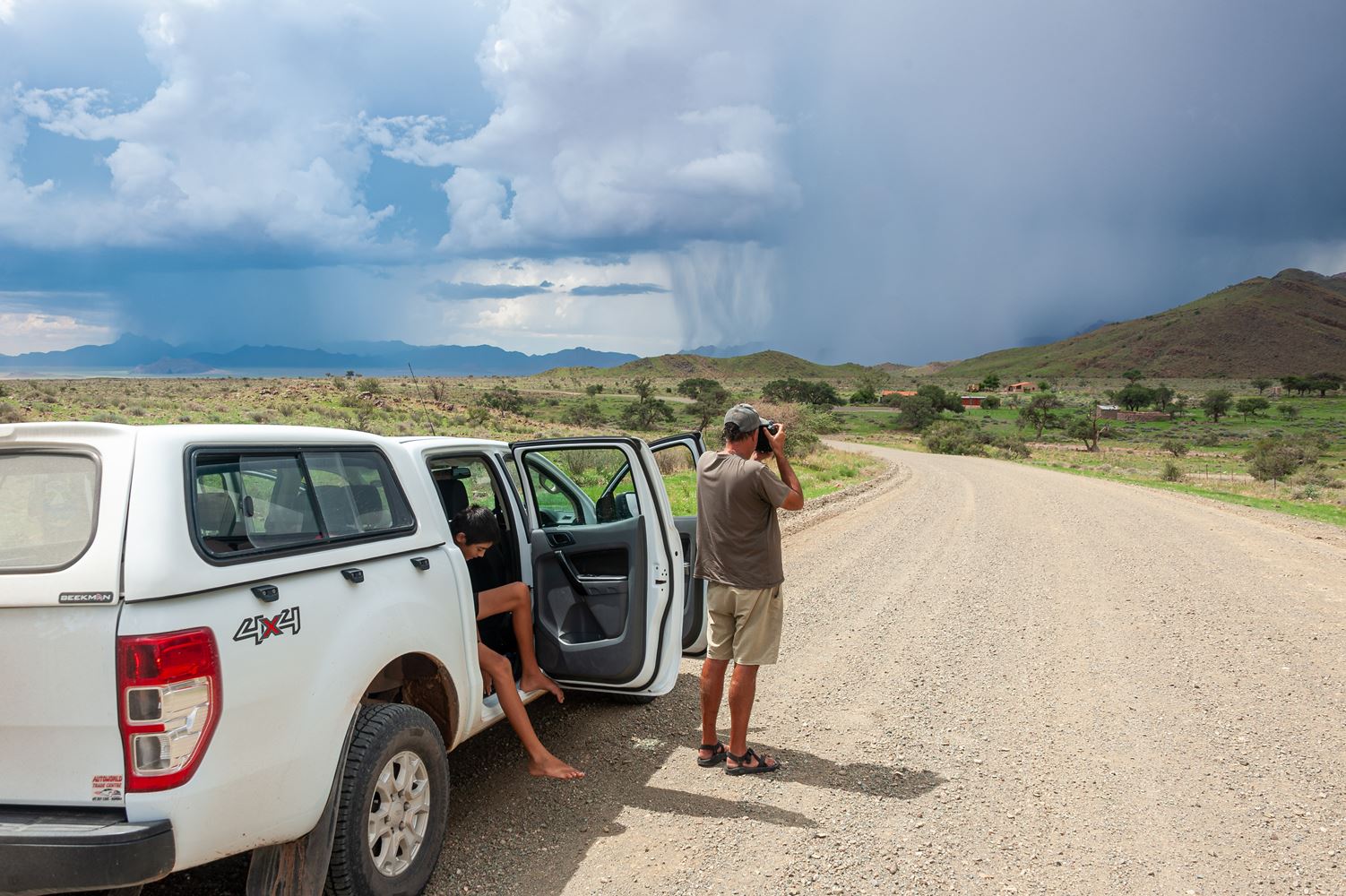
↑ An unusual amount of rain this year has turned the desert green.
We drive north to Sesriem with the intention to drive in to the Sossusvlei National Park. Matt has booked us into a camping ground at Sesriem, just at the gate to the National Park, about 60km from Sossusvlei itself.
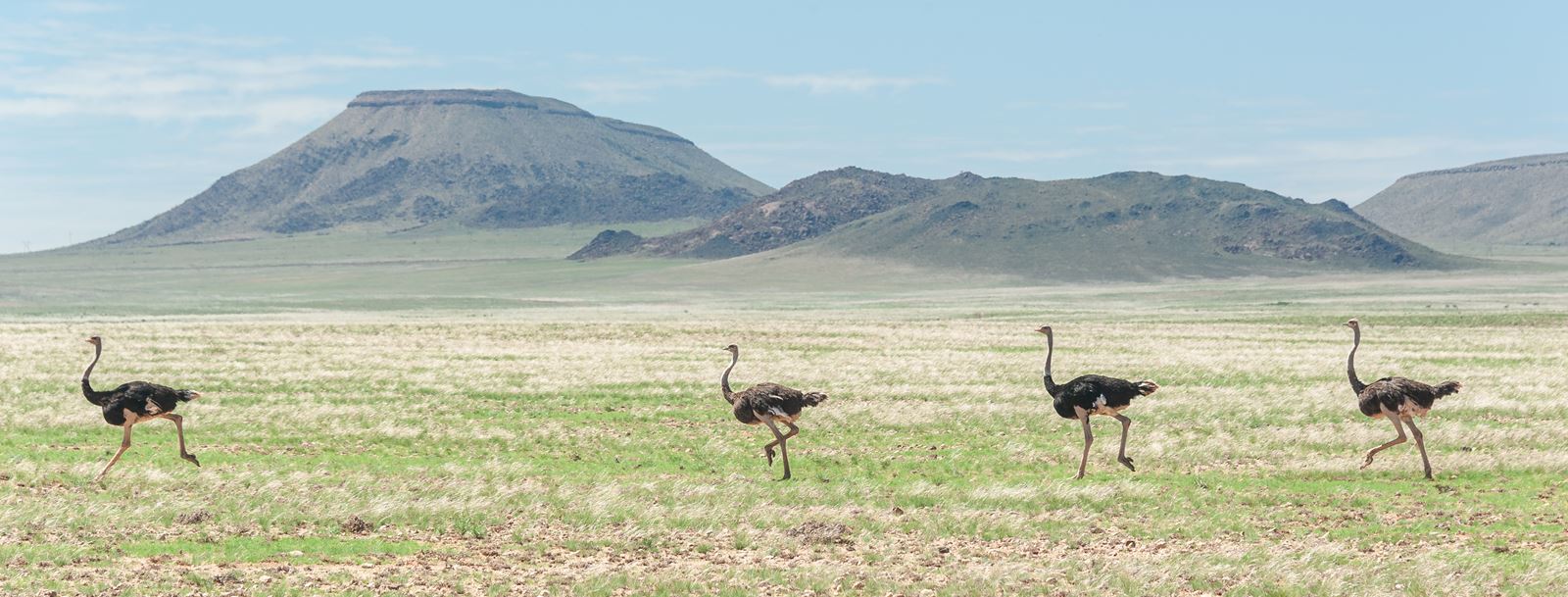
↑ There is a surprising amount of wildlife in the desert.
The light on the landscape as we drive inland is soft and dappled over the stony treeless desert, contrasting with the rugged and interesting mountains in the distance. It's a dirt road, but we have it to ourselves once we clear Luderitz, and Matt sits on about 110km/h. Occasionally, we come across road damage from rain, patches of mud and water, but nothing serious.
At Sesriem, we book into the camping ground, set out our tents, dine at the restaurant, and come back to a great camp fire and a bottle of wine.
I sleep very well and am up before dawn, ready for the planned 60km drive into Sossusvlei, but nature has other plans. About 20km in there is a magnificent dune on our right. We can see it in the early light but keep going with that dune as a promise of things to come. A few km further on we see cars stopped ahead of us. As we pull up behind them we see that the road is cut.

↑ Floods stop us getting to Sossusvlei.
It turns out that the first few cars made it across before the flood rose. It's now a torrent of rushing water with enormous standing waves marking the edges of the roadway. It's hard to tell how deep it is but nobody is game enough to find out. Walking across is out of the question – you'd be washed off your feet. Driving across *might* be possible, if the water stayed below the car, but if it is too deep and that current hit the side of the car it would be washed downstream in a very ugly way. It soon becomes clear that the water is still rising and so we turn around and go back to the dune we just passed.
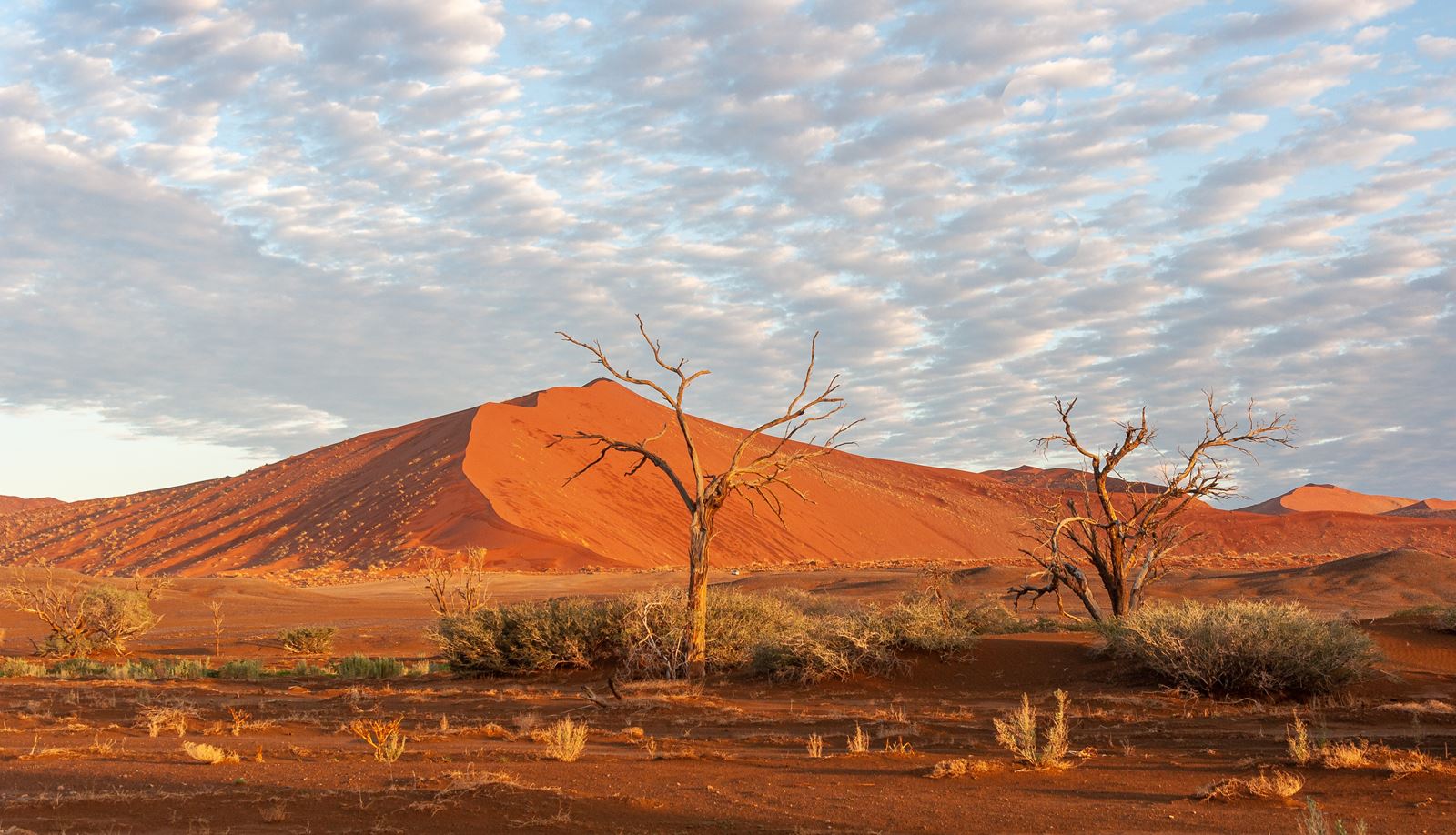
↑ The big dune

↑ From the big dune we can see the flooded river and Sossusvlei in the distance.
The big dune turns out to be even more fabulous when we get close. Matt, Jen and their boys climb maybe half way up. I don't see much point in going even that far. It is hard work climbing the ridgeline in the soft sand, and as the sun gets higher the sand gets very hot – so hot that my bare feet can't take it. So I head back down, well satisfied with my dune-climb and not at all disappointed at missing Sossusvlei.
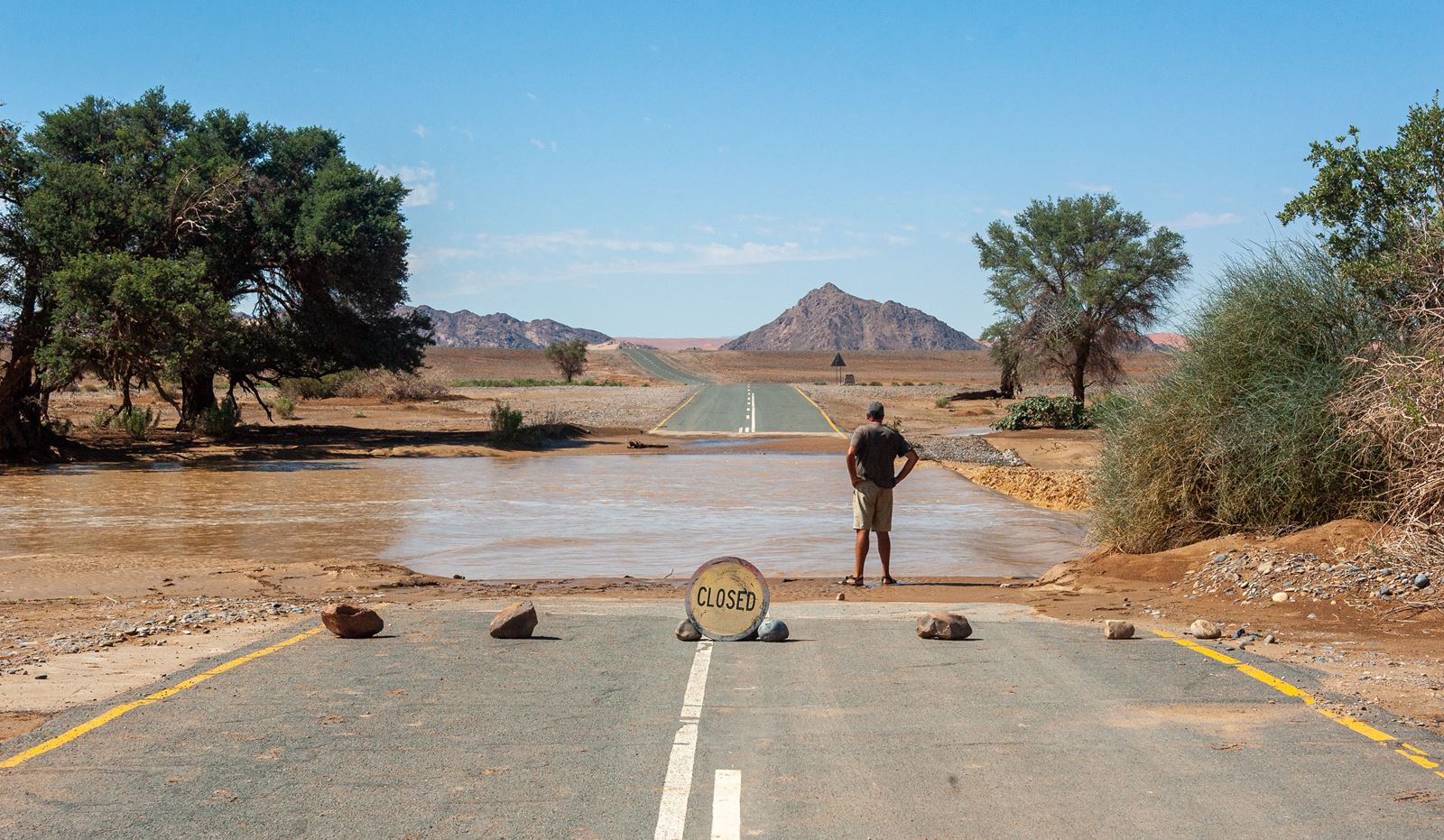
We check the river again but it's still too high and so we decide to try for Duwisib Castle, an anachronistic stone house built in the early 1900's by Baron von Wolf for his American bride. Why? Who knows. But our plans are foiled again! The same river has also cut the road to Duwisib Castle. We head back to the camping ground at Sesreim, expecting to spend another night, or more, waiting for the river to subside. As we eat lunch at the restaurant bar one of the local National Park guys explains that we can take another road and get back to Luderitz. The local bus has just got thru so we should have no problems.
Off we go again. The river spreads out and divides into several channels, each one muddy and shallow. The first two are no problem but the third channel seems deeper. Still, we can see fresh tyre tracks leading in and out, and we know the bus made it, so we give it a go, and it's fine.
As we head back to Luderitz a huge thunderstorm hits. The wind before the storm whips up thick dust but the dust is soon replaced with lashing rain that forces us to a crawl. The storm is intense but short-lived and we are soon driving thru a beautiful desert landscape dusted with light green shoots of grass from showers earlier this month.
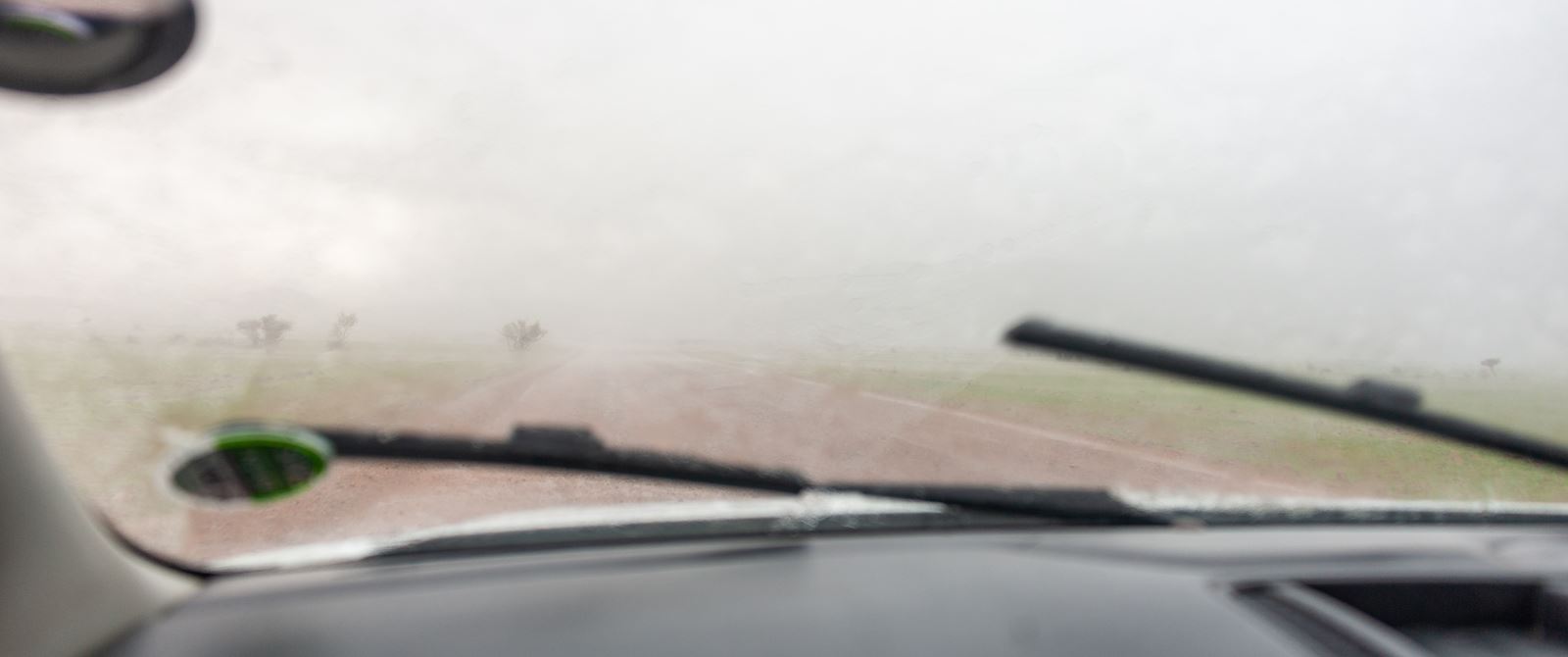
Africa is wet! Parts of Africa, around the Lakes in Kenya/Malawai/... are being flooded by the rising level of the waters.
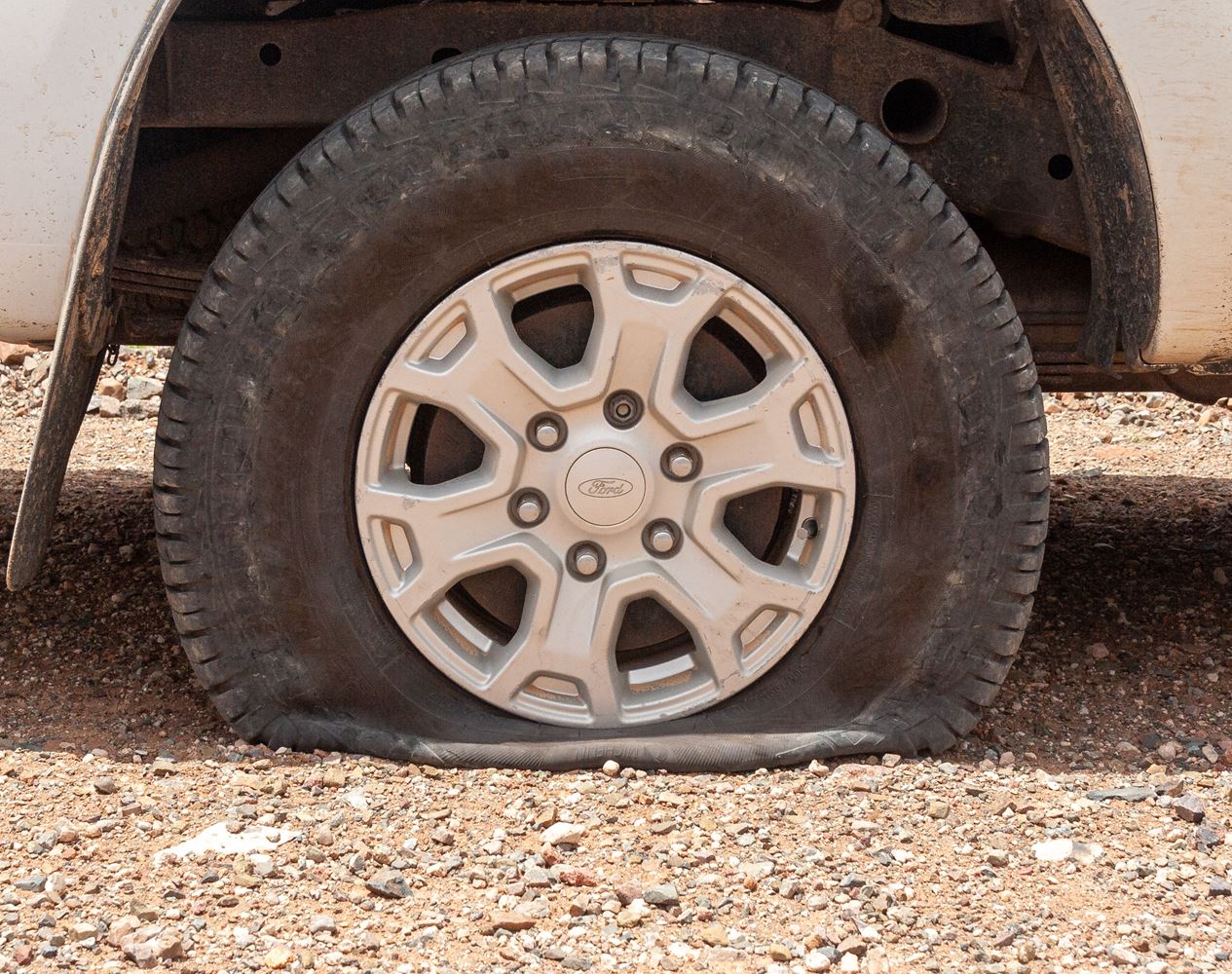
↑ And of course we get a flat tyre, but Matt soon has it fixed.
Before making Luderitz we encounter several more storms, but eventually we get into town about 1800.
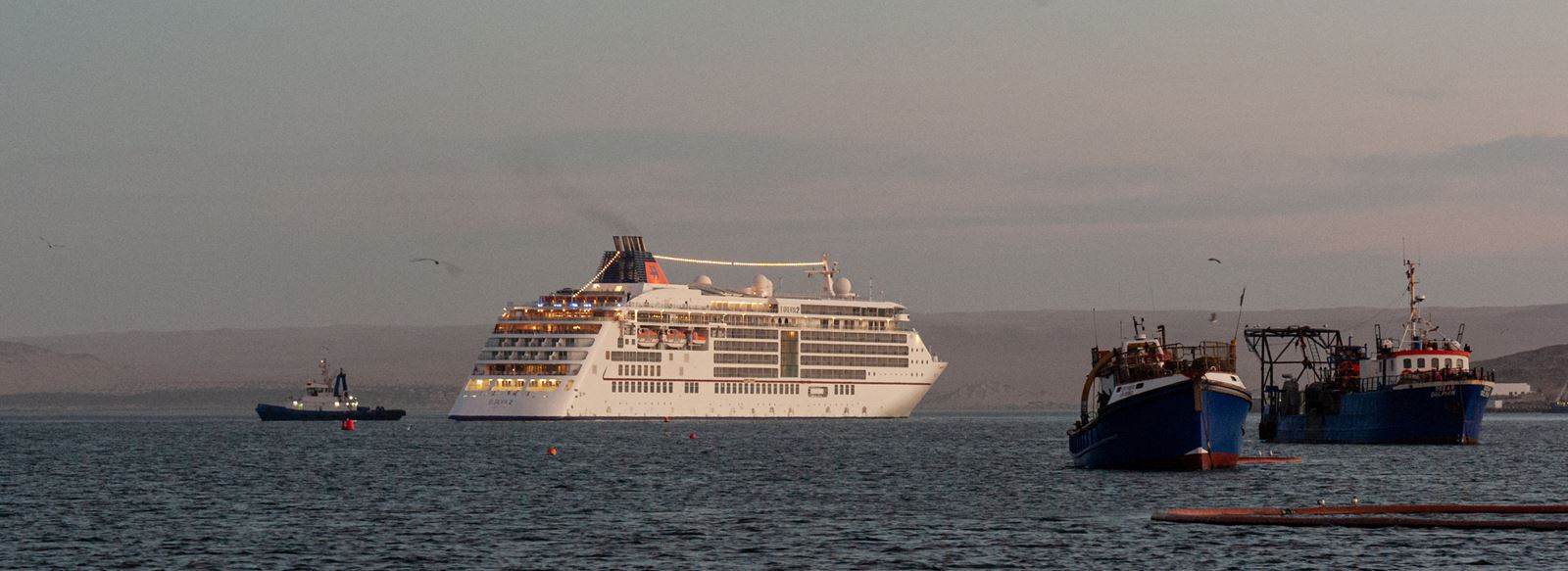
Next morning I arise at dawn to the staggering sight of a Christmas tree at the back of the boat! As I wipe the sleep from my eyes the Christmas tree resolves into the Europa 2, a cruise liner, in the middle of Luderitz Port. I watch as two tugs fuss about trying to push the monster into the channel leading to the port. In the end the tugs scoot off in separate directions and the ship makes its own way up the channel slowly backing up to the pier for a perfect landing. I can't imagine how the skipper trained for this job. Somewhere there is a cruise ship with lots of dings in it.
A 'lay day' today and I enjoy a day by myself on the boat while Merel explores on the bike. About 1430 the Europa 2 gives three blasts and heads forward up the channel. When I went to school three blasts meant going astern. It's hard to see the point of that ship coming in here for 8 hours. Maybe just enough time for a few of them to visit Kolmanskop, but that's about all. Why anyone would want to travel that way?
Andy, the local fixer and broker for our privately owned mooring, is renovating a trimaran moored just next to us. I visit him one day. He shows me a photograph of a handsome young man next to a deep sea diving suit.
"That's you!" I exclaim.
"That's me in the 70's" He confirms. "I went down over 1,000 metres in that suit, and I still have it. I know where there is sunken treasure and I intend to find it."
His plan is to locate a particular sailing ship laden with Peruvian gold and artifacts, and collect a reward. With the proceeds of that he will retrieve another treasure ship wrecked on a rock off Cape Agulhas. He goes into the details. It's a bold plan full of intrigue, twists and turns. It's one thing knowing where the sunken treasure is; it's quite another to get your hands on it because everyone else thinks they have a right to it as well. Still, if the plan doesn't work he can always sell the movie rights.
Merel wants to introduce me to her new friend Giel who has a grand plan for island communities. Giel is an entrepreneur, researcher, inventer and dreamer who has developed a bunch of ideas that he believes will benefit islanders, especially around waste, recycling and energy. So we walk up the hill above the waterfront and as we approach Giel's place there is a honking of horns, shouts, and drums. Around the corner below us a bunch of protesters march past. We are too far away to read their banners.
Giel walks us through his favorite project: the Biogas Digester. His energy is infectious and Merel says she will make a video and I volunteer a website.
I ask him what the protest is about "The pharmacist killed a local boy" he explains "The police are still gathering evidence. It's complicated. The protesters think the police are reluctant to charge him." I think he means that a prescription mistake was made, but it turns out that isn't the case at all. The man has a history of violence and the boy died a violent death.
The second of Giel's projects is a way to create a high-temperature burn on a beach, suitable for burning plastic. The following day we go to the local beach and dig a hole, which collapses because we've located it a bit too far up the beach where the sand is too dry. We should have dug it in slightly wetter sand where it would hold together. Amid some frustration with the collapsing walls Giel manages to get the furnace going and it roars away quite impressively, quickly devouring our collection of plastic waste. Merel videos the whole process and we go back to the boat and spend a few days figuring out how to drive Da Vinci Resolve to put it all together. Finally, we have a web site and a couple of videos but not enough bandwidth to upload it all before we leave for Walvis Bay.
Walvis Bay
Like Luderitz, Walvis Bay is a centre for fishing and diamonds, but it also has a major container terminal that services all of Central Africa, making it the biggest port in Sub-Saharan Africa. Transport to surrounding countries is by road and big trucks line up in long queues at the port, patiently waiting to pick up or offload their containers. This system was devised, financed and engineered by the Chinese, but I see no Asian faces here. As a bonus, some Chinese designer tacked a small marina onto the port structure, but the locals can't work out the politics of how to run it so it sits unused and yachts must anchor out.
The sail up the coast from Luderitz was eventful. We stopped in Hottentot Bay, hopeful that we could go ashore and explore. Cerriane V with Michael, Myra and Jaco, were there with us but none of us left our boat. The wind blew at over 30 knots and big rollers made their way into the bay, ending as spectacular surf on the beach – no way was our little rowboat going to survive a landing there.
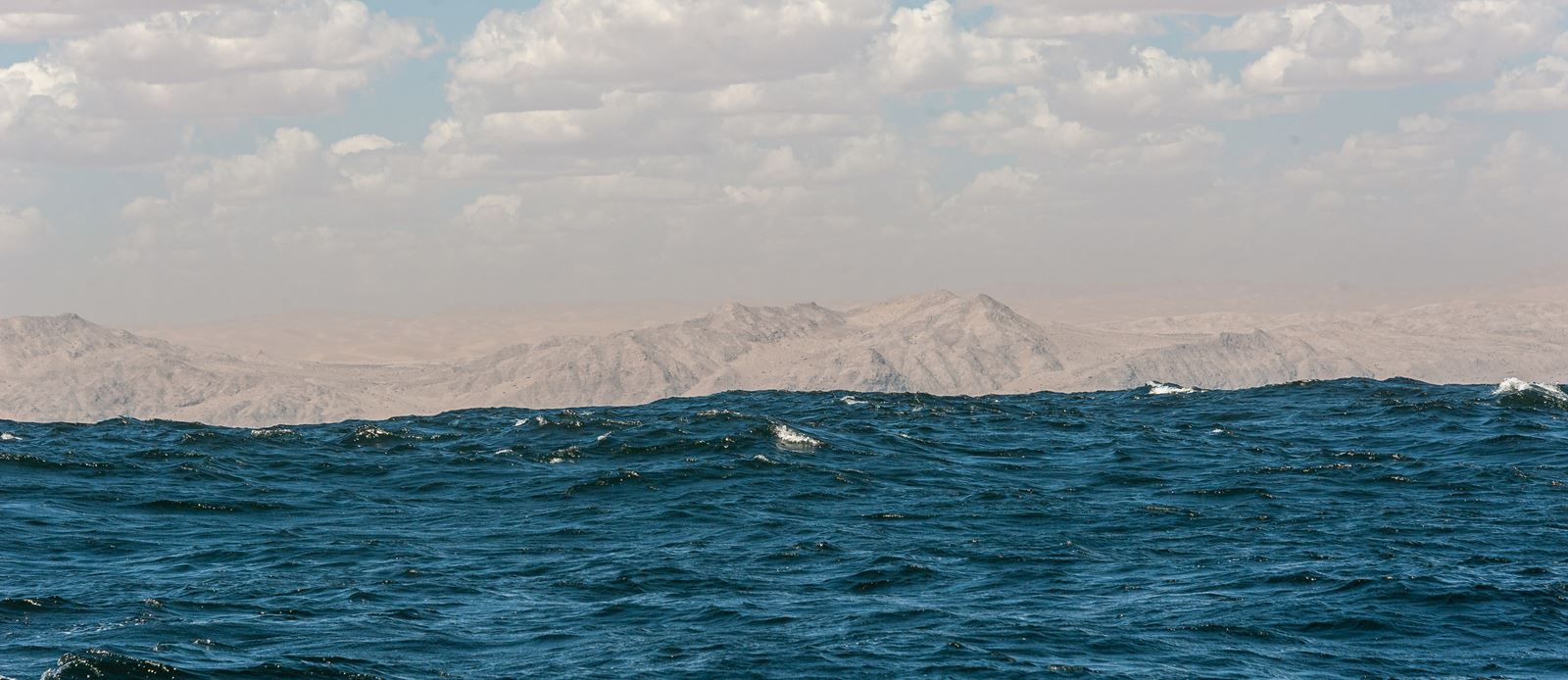
↑
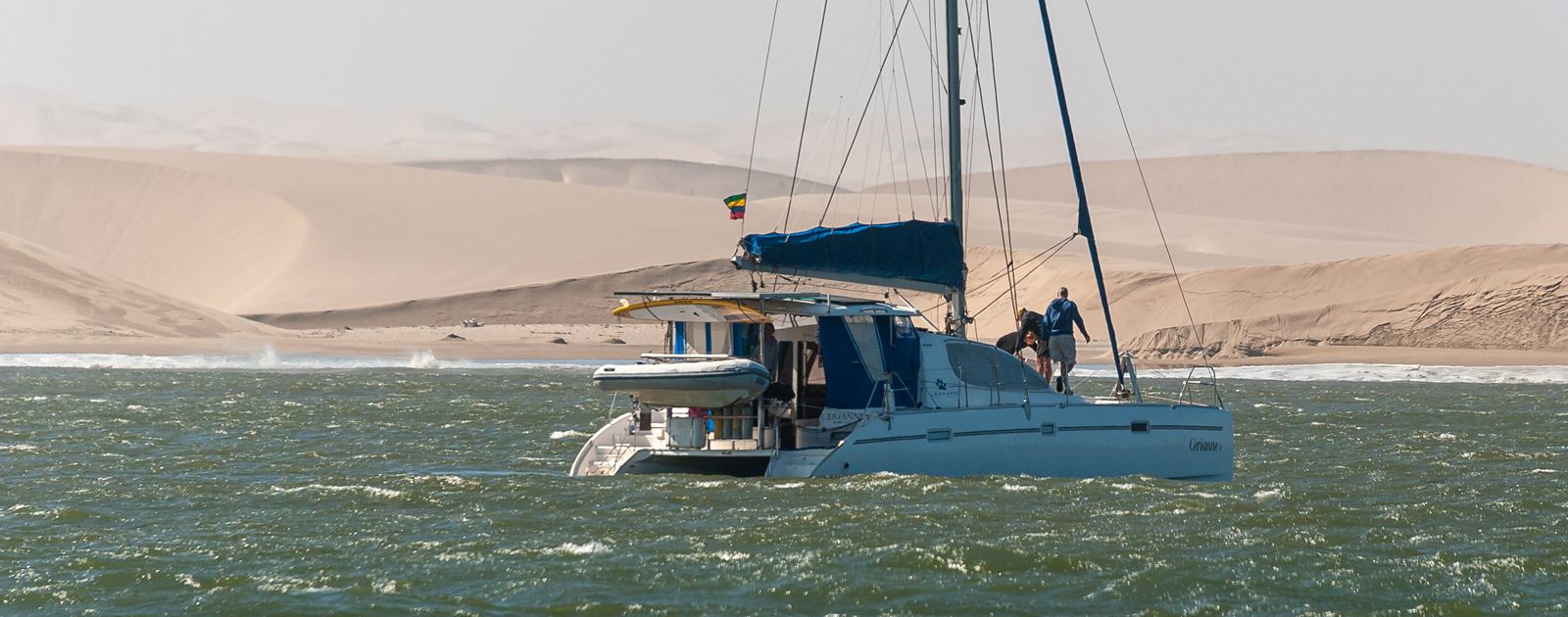
↑ Cerriane V. The surf on the beach is huge when you realize the beach is about a mile away!
So we spent one uncomfortable night at anchor and headed back out to sea next morning where we picked up a good breeze most of the way to Walvis, with just one light patch in the middle. As we rounded Pelican point at the entrance to the bay we had the wind in our faces and chose to motor into it rather than tack up the bay. It's a long way from Pelican Point to the anchorage outside the yacht club and it took about an hour. We finally arrived about 2300, anchored and went to bed for our first decent sleep in five days.
Next morning we go ashore to the yacht club where I meet Danel, the secretary, who is extremely helpful in trying to find local marine professionals. There is a lot of expertise here because of the shipping and fishing industries, but it can be hard to find as yachts are a minority. That afternoon we meet her partner, Theo, the club Commodore. Theo is a lively 65 year old with a penchant for doing things properly. Merel manages to borrow a key to his lockup so we can store the bike ashore and it's neat and tidy with a place for everything. The club is just the same: well run, great staff, well trained. The club restaurant and bars are open to the public and are one of the more popular waterfront establishments. I felt sorry for the other restaurants. One evening we were on our way back to the boat and the entire staff of one restaurant were outside smoking and chatting – they tried so hard to entice us inside as their only customers, but we had already eaten.
I finally get a new SIM card and discover free bandwidth from midnight to 0600. That night I upload Giel's website and videos. Take a peek at [Seven Seas Projects (http://sevenseasprojects.org)](http://sevenseasprojects.org) (it's a work in progress) and remember to drill down to the project detail pages to see Merel's videos – they're a hoot!
Swakopmund is a little piece of Germany in the Namib, populated mainly by people of German background and even in these covid days there are a few German tourists around. If you speak nothing but German here in Swakopmund then that's just fine, but excellent English is spoken everywhere in Namibia. Merel and I take a taxi for the 30km trip from Walvis to Swakopmund and spend the day there wandering the town.

↑ The base of the Swakopmund tower.

↑ Swakopmund caters for upmarket German tourists.
Tourist boats head out daily from Walvis to Pelican Point on wildlife trips. Tame pelicans come when called by the crew and land on deck, much to the delight of tourists. They are big stately birds that move through the crowds on the boat like it's their place, which of course it is. They are the world's luckiest birds – free to come and go as they please, socialize with other pelicans as they wish, and confident in their relationship with the humans whom they have trained to fish for them. They know that the humans expect nothing of them beyond their company, and will not peck them, torment them or eat them.
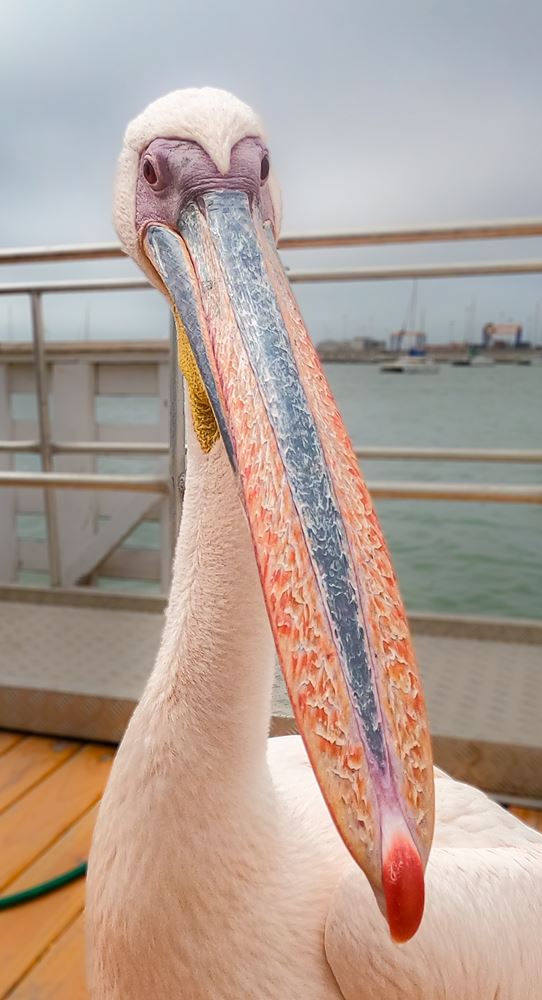
↑ What is a pelican? A life support system for the most beautiful beak imaginable.
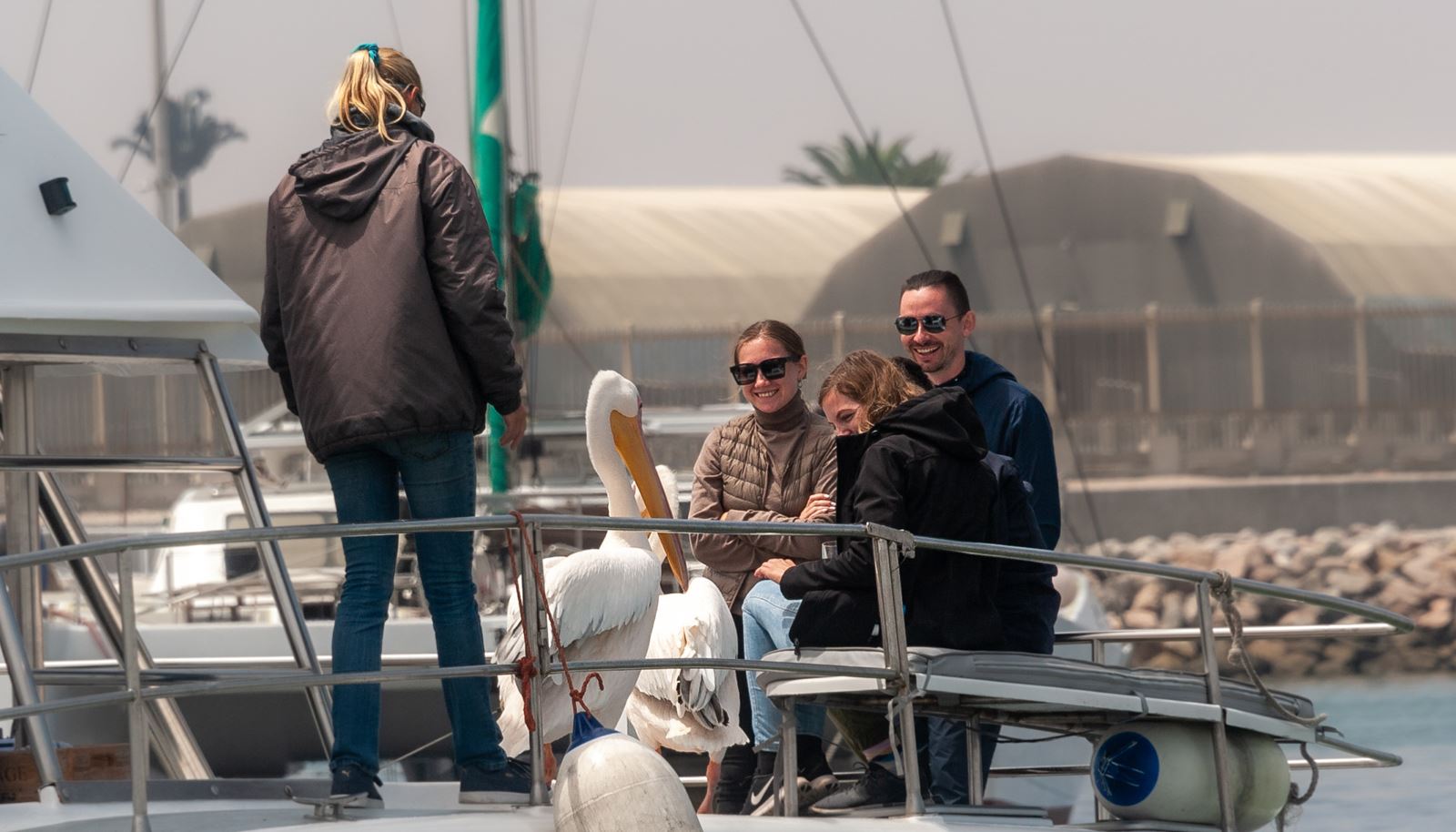
↑ The pelicans have trained the humans to feed them.
On a trip to town for diesel my taxi driver points to the small houses at the end of the street in Walvis Bay: "The Location," he says. I look blank. "It's where the blacks live." He explains. "Do you live there?" I ask. "Sure! Where else?" And that's a good point. Unless you have the income to rent or the capital to buy the only option you have is a government-subsidised plot in The Location. In South Africa they call these Townships and they are vast and ugly. Here the houses are properly constructed, with water and power. They are small and crowded, but safe places for families, schools, medical facilities and everything necessary but nothing that isn't. You could call it a kind of apartheid but the residents here are happy and aware that living in the desert is not a viable alternative, and for most people, neither is Swakopmund.
Namibia's political style could be called 'racial cooperation' in contrast to South Africa's 'racial tension'. There is a positivity in Namibia's desert air that is lost in the South African fug.
I am told repeatedly by black people that Namibia is a good country because people get along, and they get along because they need each other. Before Bartolomeu Diaz discovered Namibia in 1488 there were just a few San and Kota people living on the edges of the desert, and in southern Namibia, a few ???? people had been forced north by the Zulus. Now there are millions of blacks and only a few can trace their roots back to those original tribes. Those migrants are very aware that their government handouts are made possible by the country's wealth, whether or not they have a job.
Jobs in Namibia are highly prized. Most people are unemployed, begging is common, and the souvenir trade is suffering badly as tourists stay away in droves because of covid fears. Even though wages are low, any kind of employment is a step up from government handouts.
Goodbye Africa
The 30 knot winds of Walvis Bay have driven Anjea back on her anchor, burying it securely. With difficulty we prise the anchor out of the thick, black, sandy, African mud and head north for the entrance to the bay. We are leaving Africa.
The water inside the bay is too dirty to run the watermaker and I have just replaced the filters so I do not want to start it until we exit the bay. At Pelican Point I switch it on. The pump runs but there is no flow. Hmmm... I figure the inlet must be blocked so I suit up and jump overboard into the cold water. It takes me a while to find the right thru-hull but it's clearly not blocked.
So now I check the thru-hull valve (which I should have done first) but it's open, as it should be. Next, I take the hose off the inlet to the pump and water spurts out so I know water is getting to the pump. I take the hose off the pump outlet – no water. So I think it is the pump and am ready to turn back to Walvis. But then I accidentally tap the screwdriver against the check valve attached to the pump and suddenly water starts flowing! The non-return valve was stuck, glued shut from all the gunk in the water.
We had used all our fresh water in Walvis. Unable to make more because of the state of the bay, I was completely reliant on the watermaker to fill our tanks. If it failed we would have no choice but to turn back.
The watermaker is now rumbling away, but it's only filling the aft tank and refuses to fill the forward tank. The syphon between the tanks was broken when the water tanks got emptied, but how to re-establish the syphon? Oh well, one more puzzle to solve. It can wait.
The wind slowly fills in as we move off the coast until we have a good 20 knots behind us. Africa has long since disappeared into the thick coastal fog bank.
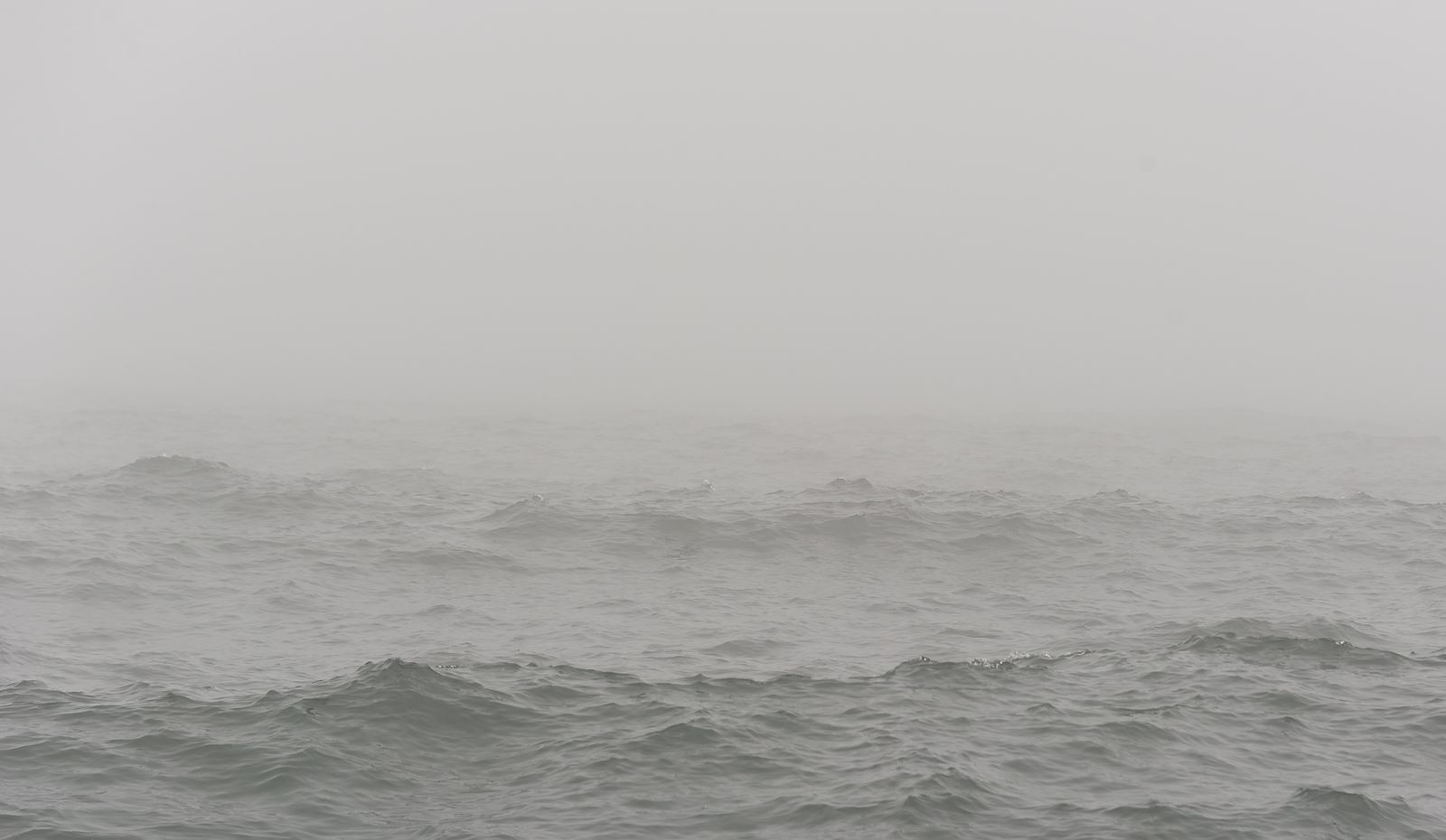

↑ Marina, age 5: Fearless, IQ200, charming, confronting and even a bit scary – the future of Africa. Self portrait.